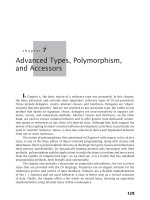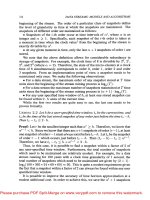Advanced Maya Texturing and Lighting- P2 potx
Bạn đang xem bản rút gọn của tài liệu. Xem và tải ngay bản đầy đủ của tài liệu tại đây (4.25 MB, 30 trang )
9
■ Understanding the art oF Lighting
Key
Fill
Ph ot o © 2008 Ju Pi t e r i mag e s CorPo rat io n
Figure 1.10 A couple receives sunlight from above and as a bounced
ll from the sidewalk. The lighting is a 2-point setup.
Lef t Ph ot o © 2008 Ju Pi t e r i ma g e s Cor Po rat io n
Figure 1.11 (Left) Hals. The Laughing Cavalier. 1624. Oil on canvas. The Wallace Collection, London. (Right) 2-point lighting
re-creation in Maya. The scene is included on the CD as
2_point.ma.
92730c01.indd 9 6/18/08 11:15:39 PM
10
c h a p t e r 1: UNDERSTANDING LIGHTING, COLOR, AND COMPOSITION ■
The intensity of the key light as compared to the fill (key-to-fill ratio) should
vary with the subject and location. The optimum intensity of any light used in a scene
depends on its position and the qualities of the materials involved. Nevertheless, as a
rough rule of thumb for an initial lighting pass, you can set the intensity of a fill light
to at least half that of the key. For the 3D reproduction illustrated in Figure 1.11, a
directional light serves as the key. The directional light’s Intensity value is set to 1.75.
An ambient light, which serves as the fill, is placed screen right with its Intensity value
set to 0.6 (see Figure 1.12).
Figure 1.12
Two-point lighting set up for the Hals
painting re-creation
The 2-point lighting scheme is not limited to portraits. Many outdoor scenes
exhibit two distinct sources of light. For example, in Figure 1.13 a watercolor street
scene portrays a strong key light in the form of the sun. An even fill along the backs
of the house and other structures represents the bounced sunlight, which serves as the
second light source.
Ph ot o © 2008 Ju Pi t e r i mag e s CorPo rat io n
Figure 1.13 Harry Leith-Ross (1886–1973). Untitled. c.1945. Watercolor on paper.
Whereabouts unknown.
92730c01.indd 10 6/18/08 11:15:44 PM
11
■ UNDERSTANDING THE ART OF LIGHTING
Using 3-Point Lighting
Perhaps the most commonly discussed and applied lighting technique is 3-point light-
ing. Descriptions can be found in numerous 3D, film, and video instructional materi-
als. Although 3-point lighting is a reliable way to light many scenes, it has inherent
drawbacks.
In the standard 3-point lighting scheme, a strong key is placed to one side of a
subject (approximately 15 to 45 degrees off the camera axis). A fill light is placed on
the opposite side and is at least half the intensity of the key (see Figure 1.14). A rim
light is placed behind the subject so that it grazes the subject’s edge.
Figure 1.14 Standard 3-point lighting applied to a mannequin. This scene is included on the CD
as
3_point_man.ma.
92730c01.indd 11 6/18/08 11:15:49 PM
12
c h a p t e r 1: UNDERSTANDING LIGHTING, COLOR, AND COMPOSITION ■
Note: Four-point lighting simply adds a fourth light to illuminate the background or set behind
the subject.
The 3-point lighting scheme is popular in the realm of 3D because it lends
depth to a potentially flat subject. For example, in Figure 1.15 a sphere is given addi-
tional roundness with three lights. A spot light, which serves as the key, is placed
screen left. An ambient light, which serves as a fill, is placed screen right. A directional
light, which functions as a rim light, is placed behind the sphere. The balance between
the key and fill creates a slightly dark “core” down the center of sphere. The bright
edge created by the rim helps separate the sphere from the dark background.
Figure 1.15 Standard 3-point lighting applied to a primitive sphere. This scene is
included on the CD as
3_point_sphere.ma.
92730c01.indd 12 6/18/08 11:15:55 PM
13
■ UNDERSTANDING THE ART OF LIGHTING
Three-point lighting was developed in the “Golden Age of Hollywood,” which
refers to the period between the advent of “talkies” and the years immediately follow-
ing World War II. Studio cinematographers developed the technique as an efficient
way to light scenes when time was somewhat limited and production schedules had
to be met. When lighting actors, cinematographers often sought out the “Rembrandt
patch,” which is a triangular patch of light on the cheek opposite the light source (see
Figure 1.16). The patch was named after the painter, who often featured such a pat-
tern in his portraits.
Lef t Ph ot o © 2008 Ju Pi t e r i ma g e s Cor Po rat io n
Figure 1.16 (Left) Rembrandt. Portrait of an Old Woman. c. 1650. Oil on canvas. Pushkin Museum of Fine Arts, Moscow.
(Right) Modern photo with similar “Rembrandt patch” on subject’s left cheek.
Rim lights, in particular, were developed to separate the actor from a dark or
cluttered background. Rim lights (and other fundamental aspects of lighting design)
can trace their roots to early theatrical stage lighting. Early examples of their use in
motion pictures include, but are not limited to, Old and New (1929), directed by
Sergei Eisenstein, and the 1920s comedies of Charles Chaplin (A Woman of Paris,
Gold Rush, and so on). Eventually, rim lights were used to impart a fantastic glow to
the hair of heroines such as Ingrid Bergman in Casablanca (1942), Rita Hayworth in
Gilda (1946), and Grace Kelly in Rear Window (1954). The use of rim lights does not
necessitate the use of a definitive fill light. Glamour lighting, a name loosely given to
the lighting style of publicity photography of American motion picture studios from the
1920s to the 1940s, often used only a key and a rim (see Figure 1.17). A variation of
this technique, known as butterfly lighting or Paramount lighting, places a high key
directly in front of the subject (thereby creating a shadow in the shape of a butterfly
under the nose).
92730c01.indd 13 6/18/08 11:15:57 PM
14
c h a p t e r 1: UNDERSTANDING LIGHTING, COLOR, AND COMPOSITION ■
Ph ot os © 2008 JuPi t e r ima g e s Cor Po rat ion
Figure 1.17 Three variations of glamour lighting, as seen in photographs of Jane Wyman (left), Ida Lupino (center), and Mary
Pickford (right).
Proper 3-point lighting is fairly difficult to find in the world of painting.
Clearly defined rims are not generally painted in. In many cases, a portion of a sub-
ject that is dark is allowed to blend into a dark background (see Figures 1.4, 1.5,
and 1.6). In other situations, the chosen background is bright enough to delineate
the outline of the subject. In Figure 1.18, the man’s dark hair and the shadow on his
left shoulder are offset by a pool of light on the back wall. This strategically placed
pool serves the same function as a rim light, but isn’t part of the modern 3-point
lighting method.
On the other hand, rim lighting can often be found in nature. For example, in
Figure 1.19 a cloud covers the sun and picks up a bright rim. Intense sunlight strikes
a cactus from behind, thereby illuminating its spines. A woman’s hair is lit from light
streaming through a window. These natural occurrences, however, do not fit the
standard 3-point lighting system. None of the subjects are affected by more than two
distinct sources of light.
Many contemporary cinematographers and videographers consider 3-point
lighting either antiquated or unsatisfactory for many lighting situations. The necessity
of specific positions for key, fill, and rim lights guarantees that 3-point lighting does
not match many real-world situations. The alternative to 3-point lighting is thus natu-
ralistic lighting.
92730c01.indd 14 6/18/08 11:16:00 PM
15
■ Understanding the art oF Lighting
Ph ot o © 2008 Ju Pi t e r i mag e s CorPo rat io n
Figure 1.18 Giovanni Battista Moroni (1520–78). The Tailor. c. 1565. Oil on
canvas. National Gallery, London.
Ph ot os © 2008 JuPi t e r ima g e s Cor Po rat ion
Figure 1.19 Naturally occurring examples of rim lighting
92730c01.indd 15 6/18/08 11:16:06 PM
16
c h a p t e r 1: UNDERSTANDING LIGHTING, COLOR, AND COMPOSITION ■
Using Naturalistic Lighting
Naturalistic lighting is an adaptable scheme that matches the natural lighting scenario
of the subject location. Any light that is visible is logically driven by a recognizable
source. Naturalistic lighting is sometimes called “transparent” in that no artificial
lighting methods can be detected. Another way to define naturalistic lighting is to list
what it lacks:
U• nmotivated shadows
I• mpossibly distinct rim light
P• erfectly placed lights that never permit a character to fall into shadow or be
unglamorously lit
In the field of motion pictures, there are numerous examples of non-naturalistic
lighting. Many films feature stylized or exaggerated lighting. This is particularly evi-
dent with musicals, which are fantastic by their very nature. Such films as The Band
Wagon (1953) and Silk Stockings (1957) employ high-key lighting, in which the fill
light is intense and there is a low key-to-fill ratio. The characters in these films are
therefore evenly lit and carry a minimum number of deep, dark shadows. High-key
lighting is also evident in many television sitcoms, in which it is necessary to keep a
character well lit at all positions on the set. Similar lighting is employed for advertis-
ing and catalog art (see Figure 1.20).
Ph ot os © 2008 JuPi t e r ima g e s Cor Po rat ion
Figure 1.20 High-key lighting demonstrated by ad photography
In other situations, non-naturalistic lighting is a result of technical limitations
or time and budget restrictions. A common problem with older motion pictures is the
unintended creation of unmotivated, multiple shadows. For example, light represent-
ing the sun casts multiple shadows of a character on the ground. More commonly,
a lamp casts multiple, distinct shadows of its own fixture (see Figure 1.21). This is
caused by a need to illuminate a set with multiple lights to attain correct exposure
even though the desired light source—in terms of the story—is singular.
92730c01.indd 16 6/18/08 11:16:08 PM
17
■ UNDERSTANDING THE ART OF LIGHTING
Figure 1.21 A lamp unrealistically casts three sharp shadows of itself (as seen in
a frame blowup from a 1950s motion picture).
In contrast, naturalistic lighting is often found in post-1950s historical dramas,
particularly those set in times before the advent of the lightbulb. Prime examples
include Barry Lyndon (1975), directed by Stanley Kubrick (1928–99), and 1492
(1992), directed by Ridley Scott (1937–). In these works, lighting is motivated by com-
binations of sunlight, moonlight, candlelight, and firelight. Keys, fills, and their result-
ing shadows are often extremely soft. The naturalistic lighting approach is not limited
to historical drama, however. Kubrick also employed naturalistic lighting in such films
as A Clockwork Orange (1971) and The Shining (1980).
In the world of art, naturalistic lighting can be found in any of the paint-
ing genres that placed a premium on accurate lighting. For example, Jan van Eyck
(1385–1440) was an early adopter of physically accurate painting. In Figure 1.22, the
light from several windows bounces through a room, creating soft shadows along the
way. Van Eyck helped to establish the style of the Early Renaissance, which placed an
importance on the study of the natural world.
In addition to chiaroscuro works, the baroque movement produced many natu-
ralistic paintings. The movement placed an emphasis on emotionally and physically
accurate portrayals of subjects. Two Dutch painters, Jan Vermeer (1632–75) and Pieter
de Hooch (1629–84), were particularly successful at rendering soft, naturally lit inte-
riors and exteriors. For example, in Figure 1.23 a sunset sky provides a diffuse light
within a building’s shadow for a threesome at a table, yet brightly lights buildings in
the distance.
92730c01.indd 17 6/18/08 11:16:10 PM
18
c h a p t e r 1: UNDERSTANDING LIGHTING, COLOR, AND COMPOSITION ■
Ph ot o © 2008 Ju Pi t e r i mag e s CorPo rat io n
Figure 1.22 Van Eyck. Giovanni Arnolni and His Wife Giovanna Cenami. 1434. Tempura
on wood. National Gallery, London.
Realism, as an art movement, appeared in the mid-19th century and placed a
premium on an accurately portrayed world with no hint of idealism or romanticism.
Realist artists include George Caleb Bingham (1811–79) and Jules Breton (1827–1906),
both of whom are noted for their accurately rendered outdoor scenes. Impression-
ism, centered in France in the 1860s and considered a branch of realism, sought to
faithfully portray light and color as perceived by the human eye. This attention to
light is illustrated by Figure 1.24. A woman stands at a bar in front of a large mirror.
The painting was created at a real location and was not staged in the artist’s studio
(this preference was known as “plein-air,” or “open-air”). Although the scene is quite
cluttered with detail, little attempt has been made to separate the woman from her
surroundings. That is, there is no artificial rim light or artifacts of a specific lighting
scheme. This is equally true of the bottles at the lower left; their forms begin to merge
into a single mass. (Although the lighting is accurately portrayed, the mirror’s reflec-
tion lacks the artist and skews the entire background for compositional convenience.)
Famous impressionistic painters include Edgar Degas (1834–1917), Claude Monet
(1840–1926), Pierre-Auguste Renoir (1841–1919), and Édouard Manet (1832–83).
92730c01.indd 18 6/18/08 11:16:15 PM
19
■ Understanding the art oF Lighting
Ph ot o © 2008 Ju Pi t e r i mag e s CorPo rat io n
Figure 1.23 De Hooch. A Musical Party in a Courtyard. c. 1677. Oil on canvas.
National Gallery, London.
Ph ot o © 2008 Ju Pi t e r i mag e s CorPo rat io n
Figure 1.24 Manet. A Bar at the Foiles-Bergére. 1882. Oil on canvas. Courtauld Institute Galleries, London.
92730c01.indd 19 6/18/08 11:16:21 PM
20
c h a p t e r 1: UNDERSTANDING LIGHTING, COLOR, AND COMPOSITION ■
Naturalistic lighting, by its very nature, does not dictate a fixed number of
lights or specific light locations or intensities. However, you can use the following
guidelines to assist you during setup:
D• etermine what the strongest light is and where it should be coming from. Is
the light source visible within the frame or is it arriving from offscreen? Set one
or more key lights in appropriate locations. Match the type of light to the type
of source. (See Chapter 2 for more information on Maya light types.) Render
tests to determine the appropriate intensities of the key or keys before adding
fill lights.
D• etermine what secondary light sources are needed. Are these sources physical
(that is, a lamp, a candle, and so on), or are they actually the bounced light of
the strongest light source? Set fill lights in the appropriate locations. If you are
copying an existing location, replicate the key-to-fill ratio. If the scene you are
creating does not exist in the real world, apply a key-to-fill ratio that is similar
to an equivalent location in the real world.
W• hen applying shadows, replicate the type of shadow that is naturally pro-
duced by a specific light source. For example, midday sunlight creates hard-
edged parallel shadows (see Figure 1.25). An artificial source close to the
subject, such as a lightbulb, produces a shadow that widens and softens over
distance. (See Chapter 3 for information on shadow creation in Maya.)
Ph ot os © 2008 JuPi t e r ima g e s Cor Po rat ion
Figure 1.25 (Left) The sun creates parallel shadows of stone columns. (Right) An articial light source creates a
shadow that widens and softens over distance.
C• olor is equally important when reproducing a particular location. Different
light sources create different wavelengths of light, which in turn produce spe-
cific hues that are perceived by the human eye or recorded on a medium such as
film or video. (See Chapter 2 for information concerning Maya light color. For
information on color temperature, see “A Note on Color Temperature” at the
end of this chapter.)
92730c01.indd 20 6/18/08 11:16:23 PM
21
■ UNDERSTANDING THE ART OF LIGHTING
For practice, you can always re-create existing images. For example, in
Figure 1.26 the lighting of a Vermeer painting is replicated in 3D.
Lef t Ph ot o © 2008 Ju Pi t e r i ma g e s Cor Po rat io n
Figure 1.26 (Left) Vermeer. A Lady Standing at a Virginal. 1673. Oil on canvas. National Gallery, London. (Right) Naturalistic
lighting re-creation in Maya. The scene is included on the CD as
naturalistic.ma.
Using Stylized Lighting
Stylized lighting pays no heed to the real world but fabricates fantastic sources of light
or simply ignores the lighting information altogether.
The oldest form of stylized lighting can be called 0-point lighting. In this case,
lighting plays no part in the artistic representation. You can see this in prehistoric
art, as well as in the art of ancient or primitive cultures (see Figure 1.27). To this day,
0-point lighting survives as line-art cartoons.
Figure 1.27 Petroglyphics and hieroglyphics carry no lighting information.
92730c01.indd 21 6/18/08 11:16:27 PM
22
c h a p t e r 1: UNDERSTANDING LIGHTING, COLOR, AND COMPOSITION ■
You can find stylized lighting in numerous pieces of modern art. Many times,
this style is evident even when distinct modeling is given to the subject. (That is, the
subject is painted to have three-dimensional form.) For example, in Figure 1.28, a man
is completely disconnected from his environment. Although it can be assumed to be
night, there is no way to tell for sure. No shadows of lighting clues exist to establish a
real-world lighting scheme.
Ph ot o © 2008 Ju Pi t e r i mag e s CorPo rat io n
Figure 1.28 Vincent Willem van Gogh (18590). Portrait of Dr. Gachet. 1890. Oil on
canvas. Whereabouts unknown.
Stylized lighting is well suited for 3D animation, since the medium places no
limitation on the type of lighting employed. For 3D examples of this style, see the
section “Step-by-Step: 3D Lighting Examples” at the end of this chapter.
Understanding Color and Composition
Successful lighting is not dependent on appropriate light placement alone. One cru-
cial component is color. Unfortunately, it is beyond the scope of this book to cover the
bulk of color theory. However, a discussion of the RYB and RGB color models, color
wheels, color space, color temperature, and light color is worth a look.
At the same time, composition is a critical component of any animation that is
rendered. Composition—the aesthetic arrangement of objects within a frame—can be
reduced to the golden mean and the rule of thirds.
92730c01.indd 22 6/18/08 11:16:29 PM
23
■ UNDERSTANDING COLOR AND COMPOSITION
Color Theory Overview
In the traditional color theory model, red, yellow, and blue are considered primary
colors. As such, they follow these rules:
N• o combination of any two primary colors can produce a third primary color.
C• ombinations of all three primaries can produce a wider range of colors than
any other combination of colors.
You can form secondary colors by mixing together primary colors, which
produces orange, green, and violet (purple). You can form tertiary colors by mixing
primary colors and secondary colors; the resulting colors are generally given hyphen-
ated names, such as blue-green. The primary, secondary, and tertiary colors are often
represented by a 12-step color wheel (see Figure 1.29).
RYB RGB
P= Primary colors
S = Secondary colors
T = Tertiary colors
P
PP
SS
S
T
T
TT
T
T
T
TT
T T
T
P
S
PS
P
S
Figure 1.29 (Left) Red-yellow-blue (RYB) color wheel re-created in Maya. The scene is included on the CD as RYB_wheel.ma.
(Right) Red-green-blue (RGB) color wheel re-created in Maya. The scene is included on the CD as
RGB_wheel.ma.
The red-yellow-blue (RYB) color theory model evolved in the 18th century and
was based on color materialism, which assumes that primary colors are based on spe-
cific, indivisible material pigments found in minerals or other natural substances. The
popularization of specific RYB colors was aided by printmakers such as Jakob Christ-
offel Le Blon (1667–1741), who developed the color separation printing process. The
color wheel itself was invented by Sir Isaac Newton (1642–1727) in 1704, although his
variation contained seven hues visible when white light was split by a prism.
The development of computer graphics, however, has added a new set of pri-
mary colors: red, green, and blue, or RGB. This produces its own unique color wheel
(see Figure 1.29). Through an additive process, computer monitors mix red, green,
92730c01.indd 23 6/18/08 11:16:34 PM
24
c h a p t e r 1: UNDERSTANDING LIGHTING, COLOR, AND COMPOSITION ■
and blue light to produce additional colors. Added in equal proportions, RGB pri-
maries produce white. In contrast, the RYB color theory model is subtractive in that
the absence of red, yellow, and blue produces white (assuming that the blank paper
or canvas is indeed white). In this case, if colored paint or ink pigments are present,
they absorb certain wavelengths of light, thus preventing those wavelengths from
being reflected back at the viewer. When combined in equal proportions, the RYB
primaries produce black (having absorbed all visible wavelengths of light). Modern
printing techniques follow the subtractive model by utilizing cyan, magenta, and yel-
low primary inks, with the addition of black ink (CMYK, where K is black). Cyan,
magenta, and yellow happen to be secondary colors on the RGB color wheel. Maya’s
Color Chooser window represents the RGB color wheel as a hexagon shape; primary
and secondary colors are located at the corners of the hexagon. (For more information
on the Color Chooser, see Chapter 6.)
Despite the disparity between color theory models, methods of using a RYB
color wheel are equally applicable to RGB color wheels. As such, the goal of color
selection is color harmony, which is the pleasing selection and arrangement of colors
within a piece of art. The most common methods of choosing harmonic colors pro-
duce the following color combinations with the RGB color wheel:
Complementary colors A pair of colors at opposite ends of the color wheel. For
example, in Figure 1.30, the blue-cyan body and red-orange head of a bizarre charac-
ter compose a complementary color set.
© 2005 Le e Lan ie r
Figure 1.30 A blue-cyan body and a red-orange head form complementary colors. This still is taken from
7 Deadly Sins for the 21st Century (2005).
92730c01.indd 24 6/18/08 11:16:37 PM
25
■ UNDERSTANDING COLOR AND COMPOSITION
Split complement One color plus the two colors that flank that color’s complementary
color (for example, green, blue-violet, and red-violet).
Analogous colors Colors that are side-by-side. For example, in Figure 1.31 the cloaks
of two women are red-orange and yellow-orange. In RGB, red-orange is a mixture of
primary red and tertiary orange; yellow-orange is the mixture of secondary yellow
and tertiary orange. (If compared to the RYB color wheel, the colors correspond to
secondary orange and tertiary yellow-orange, which are also analogous.)
Ph ot o © 2008 Ju Pi t e r i mag e s CorPo rat io n
Figure 1.31 Antonio da Correggio (1489–1534). The Mystic Marriage of Saint Catherine.
c. 1520. Oil on canvas. National Gallery, London. The women’s cloaks form analogous colors.
Diad Two colors that have a single color position between them (for example, second-
ary violet and primary red on the RGB color wheel).
Triad Three colors that are equally spaced on the wheel.
Note: A common mistake made by many 2D and 3D animators is the overuse of pure primary
and secondary colors in their designs. Colors located between the secondary and tertiary elements will
provide a more diverse palette. For instance, instead of choosing 1, 0, 1 in Maya RGB color space, try
selecting 0.5, 0.4, 0.8 for a more muted variation of violet.
92730c01.indd 25 6/18/08 11:16:40 PM
26
c h a p t e r 1: UNDERSTANDING LIGHTING, COLOR, AND COMPOSITION ■
Checking Color Calibration
Maya operates in RGB color space. Color space represents all the colors that a device
can produce. The color space available to various output devices varies greatly. For
example, the color space that a television can display is significantly different from the
color space available to a computer monitor or a printer.
Never assume that a computer monitor is displaying your renders correctly. If
you are creating an animation for video, it’s best to check the resulting edit on a pro-
fessional broadcast monitor. If you are creating a render for print, bring the render
into Photoshop or a similar program, convert the RGB color space to CMYK color
space, and choose the correct color profile (see the next paragraph). If you are creating
the animation for motion picture film, calibrate your monitor based on the sugges-
tions of the service transferring the frames. Larger animation houses often maintain
their own transfer equipment. In many cases, a lookup table (LUT) is developed to
properly map the gamma of the computer monitors used by animators. Portable cali-
bration hardware is also used to check the calibration result. (The color displayed by
a monitor “drifts” over time.) Although this process may be too costly for an indepen-
dent animator, calibration shortcuts can be taken.
Many digital-imaging programs are bundled with calibration software. Adobe
Gamma is perhaps the most common. Launching the program will step you through
an interactive calibration process. Although useful, Adobe Gamma is designed for
print projects, so it might not provide accurate settings for some animation. In addi-
tion, Photoshop, along with other digital-imaging programs, offers multiple color pro-
files based on the color standards of the International Color Consortium (ICC). Color
profiles represent the color reproduction capabilities of a device. Hence, you can work
within the color limitations of a specific printer while in Photoshop. Unfortunately,
the standard profiles are not designed for film or video.
A quick-and-dirty method of checking the color calibration of a monitor involves
the use of a chip chart. For example, in Figure 1.32 a chart runs from black to white
in 11 distinct steps and in a continuous gradient. When displayed on a monitor, a
portion of the chart may appear “crushed.” (Certain steps may no longer be visible,
and the gradient may no longer be smooth.) If this is the case with your monitor, you
might unintentionally base a scene’s lighting on an inaccurate view of the scene’s
actual color space. The end result might be an animation that appears too dark and
muddy on video or too bright and washed out on film. Adjusting the brightness,
contrast, gamma, and color temperature of the monitor can alleviate this problem.
Although you can usually adjust the brightness and contrast through a monitor’s
external control panel, the gamma and color temperature are usually controlled
through a piece of calibration software (for example, Adobe Gamma). (For more
information on gamma, see Chapter 6.)
92730c01.indd 26 6/18/08 11:16:40 PM
27
■ UNDERSTANDING COLOR AND COMPOSITION
Figure 1.32 A calibration chip chart. This le is included on the CD as chip_chart.tif.
A Note on Color Temperature
Color temperature is based on the wavelength of light emitted by a material when
it is heated. Technically speaking, if a light source is said to be 5500 kelvin, it emits
the same wavelength of light, and the same color of light, as a black body radiator
heated to 5500 kelvin. A black body radiator is a theoretical material that absorbs
100 percent of the radiation that strikes it when the body is at absolute zero (–273 C°).
Although there are no true black bodies in the real world, graphite and various met-
als come close. In the original experiments by William Kelvin (1824–1907), a block of
heated carbon was used. The kelvin, on the other hand, is a measurement of tempera-
ture that adds 273 to the temperature read in Celsius. The kelvin measurement only
refers to the thermal temperature of the theoretical black body radiator and is not the
actual temperature of a light source. In other words, a fluorescent lightbulb does not
have to reach a real-world 4000 degrees kelvin to produce the same color of light as
the black body radiator at 4000 kelvin; instead, the color of the bulb is roughly corre-
lated to the color of the heated black body.
When a material is heated to a temperature above 700 K (700 kelvin), it emits
visible light. At temperatures close to 700 K, the light wavelength is long and the per-
ceived light is red. At temperatures above 6000 K, the wavelength becomes shorter
and the perceived color shifts to blue. The chart in Figure 1.33 indicates the color
temperature of various light sources and their perceived colors. The colors represented
are only a rough approximation. In addition, the color temperatures listed for each
light source are an average; depending on the circumstance or the method of manufac-
ture, color temperatures can easily vary by hundreds of kelvin.
92730c01.indd 27 6/18/08 11:16:41 PM
28
c h a p t e r 1: UNDERSTANDING LIGHTING, COLOR, AND COMPOSITION ■
Candlelight 1900 K
7500
7000
6500
6000
5500
5000
4500
4000
3500
3000
2500
2000
1500
North light (blue sky) 10000 K
Overcast daylight 7000 K
Daylight metal halide bulb 5500 K
Noon daylight, direct sun 5000 K
Cool white fluorescent 4200 K
Metal halide bulb 4000 K
Clear flashbulb 3800 K
Sunset/sunrise 3100 K
Halogen bulb 3000 K
Standard incandescent 2700 K
High-pressure sodium bulb 2200 K
Figure 1.33 Color temperatures of common light sources. This image is
included on the CD as
color_chart.tif.
Setting a White Point
In the case of monitor calibration, color temperature is used to set the white point
of the hardware. A white point is a coordinate in color space that defines what is
“white.” If a monitor is given a white point with a high kelvin value, the display has a
blue cast. If a monitor is given a white point with a low kelvin value, the display has
a yellow cast. The flexibility of the white point is necessary to match potential output
formats. For example, graphic artists who use offset printing might set their monitors
to 5500 K. For 3D animation intended for video, 6500 K generally works because
broadcast-quality video monitors have a hardware white point set to 6500 K. In con-
trast, older consumer televisions may have a white point set as high at 9300 K. Many
plasma and LCD televisions now offer the option to switch to 5400 K to better match
motion picture film.
When lighting in Maya, you do not need to know the kelvin temperature of a
light source. What is important, however, is that the color of the light logically fits the
type of source. For example, daytime sunlight varies from white to blue. Firelight var-
ies from red to orange. Incandescent lightbulbs are yellowish. If a light color is out of
place, a scene may appear incorrect to the viewer. This should not be confused with
the way colors are recorded on film, where colors are often exaggerated. For example,
daylight film (balanced for 5500 K) will make the yellow of an incandescent bulb
more orange. Tungsten film (balanced for 3200 K) will make sunlight extremely blue.
Professional photographers and cinematographers reduce this problem by employing
color corrective filters and gels. However, the end result is rarely the same as the way
92730c01.indd 28 6/18/08 11:16:45 PM
29
■ UNDERSTANDING COLOR AND COMPOSITION
it was originally perceived by the human eye. Obviously, if you are matching 3D to a
live-action plate, colors should be replicated regardless of what they might be. How-
ever, if the 3D is only meant to look real, colors—as they’re perceived by the human
eye—should be matched.
For more information on color manipulation, see Chapter 6. For information
on color bit depth, see Chapter 10.
Applying the Golden Mean
The golden mean was extolled by Pythagoras (580–500 BC) and his fellow Greeks. The
mean is a number, 1.618 . . . , that is irrational and cannot be converted to a fraction.
The golden mean defines a golden rectangle, which has an aspect ratio of roughly
1.618:1. Mathematically, a golden rectangle is a rectangle that can be partitioned
into a square and a smaller rectangle that has the same aspect ratio of the original
rectangle (see Figure 1.34). The golden mean is represented as the Greek letter phi
and is commonly referred to as the golden ratio, golden section, or golden proportion.
Although the Greeks are often given credit for discovering the golden mean, some
historians suggest that it was employed by earlier civilizations (for example, Babylonia
and Egypt).
1.618 . . .
1
Figure 1.34 The golden rectangle
Greek architects determined that the golden rectangle was aesthetically superior
to other ratios and employed the shape in many building designs. This determination
has persisted for the past two millennia in the architecture of Western civilization. As
for fine art, the golden mean was rediscovered by artists of the Renaissance, including
Leonardo da Vinci (1452–1519) and Raphael (1483–1520). Variations of the golden
mean can also be found in Medieval Islamic architecture and tile work. Many 19th-
and 20th-century artists, including Georges Seurat (1859–91), Piet Mondrian (1872–
1944), and Salvador Dali (1904–89), applied the compositional technique (see Fig-
ure 1.35). The golden rectangle survives to this day as the approximate aspect ratio
of credit and debit cards (1.6:1). The 1.66:1 motion picture aspect ratio, used exten-
sively outside North America, also comes close to the golden rectangle. (For more
information on aspect ratios, see Chapter 10.)
92730c01.indd 29 6/18/08 11:16:47 PM
30
c h a p t e r 1: UNDERSTANDING LIGHTING, COLOR, AND COMPOSITION ■
1 1.618
1.6181
Ph ot o © 2008 Ju Pi t e r i mag e s CorPo rat io n
Figure 1.35 The golden mean and golden rectangle used in a composition by Seurat. (Circus Sideshow.
1888. Oil on canvas. Metropolitan Museum of Art, New York.) The painting is repeated twice.
The golden mean has many natural occurrences. For example, the Fibonacci
series, a series of numbers in which the division of any two adjacent numbers is roughly
the golden mean, can be used to accurately predict the growth of flower petals, seeds,
seashells, pine cones, and various plant leaves.
Numerous psychological studies have been undertaken since the late 1800s to
determine if humans have a natural bias toward the golden rectangle. Conclusions
have been varied; on average, they’ve recognized the rectangle’s slight advantage.
Nevertheless, since the golden mean and its geometric corollaries have consciously or
unconsciously been used in such a large body of popular art, you can benefit from its
judicious use.
In addition to the golden rectangle, the golden mean can be expressed as a
golden triangle, a pentagram, or a decagon. For example, in Figure 1.36 the golden
triangle and pentagram are used in the composition of paintings by Raphael and
Leonardo da Vinci.
92730c01.indd 30 6/18/08 11:16:52 PM
31
■ UNDERSTANDING COLOR AND COMPOSITION
Ph ot os © 2008 JuPi t e r ima g e s Cor Po rat ion
Figure 1.36 (Left) Raphael. Madonna del Cardellino. 1506. Oil on wood. Uzi, Florence. (Right) da Vinci. Virgin and
Child with St. Anne. 1508. Oil on wood. Louvre, Paris.
Rule of Thirds
The rule of thirds is a compositional technique developed for modern photography
and videography. Simply put, you can take any frame and divide it into three hori-
zontal and vertical sections to determine the alignment of subjects (see Figure 1.37).
For example, you can align a tree, a person, or other vertical element with a vertical
line. You can align the horizon or a building with a horizontal line. The four points
at which the lines cross are considered prime compositional spots and should feature
important details in a shot (for example, a person’s face, the moon, and so on).
Ph ot o © 2008 Ju Pi t e r i mag e s CorPo rat io n
Figure 1.37 A photo divided in accordance to the rule of thirds
92730c01.indd 31 6/18/08 11:16:58 PM
32
c h a p t e r 1: UNDERSTANDING LIGHTING, COLOR, AND COMPOSITION ■
The rule of thirds is not an accurate representation of the golden mean (see Fig-
ure 1.38). However, the rule may have evolved as a simplified variation of the golden
rectangle subdivided according to the golden mean. (Unfortunately, the exact origin
of the rule of thirds technique remains murky.) The rule of thirds is useful for modern
media, such as videography, that often require quick compositional decision making.
The golden mean, on the other hand, is appropriate for painting and 3D since more
time can be spent contemplating composition. In any case, attention to compositional
detail will improve any animation you choose to tackle.
Figure 1.38 A golden rectangle (red) divided in accordance to the rule of
thirds (yellow)
Note: Screen direction, a system of motion picture rules developed over the last 100 years, dic-
tates how and where characters, vehicles, and props should be positioned and/or be allowed to move
through a series of shots. A strong knowledge of this system will allow you to make proper choices
when setting up an animation with multiple shots. You can find information on screen direction from
sources that discuss storyboarding, film direction, or editing.
Step-by-Step: 3D Lighting Examples
In this section, I’ll discuss the lighting approach of various independent animations.
The lighting style varies from naturalistic to stylized.
Millennium Bug featured a series of otherworldly characters inserted into pho-
tographs of San Francisco. Simple naturalistic lighting was employed to match the
cloudy, overcast weather conditions of the photos. In one shot (see Figure 1.39), a 3D
head was added to a preexisting crane. A single spotlight, positioned high and to the
right, served as a key. A very low intensity fill light was placed low and to the left.
The shadow of the head on the building was added in the composite. Film grain and
an artificial camera move were also added in postproduction. Millennium Bug was
created with Alias PowerAnimator on Silicon Graphics machines.
92730c01.indd 32 6/18/08 11:16:59 PM
33
■ STEP-BY-STEP: 3D LIGHTING EXAMPLES
© 1998 PaCi fi C dat a im ag e s
Figure 1.39 Millennium Bug, 1998
Mirror employed an extreme example of chiaroscuro lighting. Many shots pos-
sessed only a single key with a limited cone size and no fill. In Figure 1.40, a woman is
lit with a single spotlight from screen left. The shadow directly behind the woman was
fabricated in the composite and is hence less dense than other shadows in the shot.
Mirror was created with the original beta release of Maya.
© 2000 Lee Lan ier
Figure 1.40 M i r r o r, 2000. A QuickTime movie excerpt is included on the CD as mirror.mov.
92730c01.indd 33 6/18/08 11:17:07 PM









